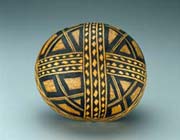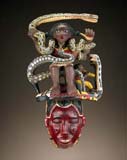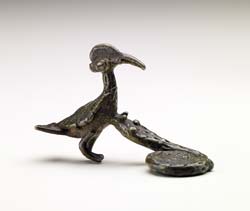
 The importance of pattern in the depictions of snakes is obvious. The pattern can stand alone, as shown on the gourd bowl (acc. no. 94-2-4), or be combined with other traits, such as the snake's zigzag movement or coiled resting state. The Akan weight of a snake catching a bird refers to a proverb about the patience of a snake that waits to catch an unwary bird (73-7-204). The importance of pattern in the depictions of snakes is obvious. The pattern can stand alone, as shown on the gourd bowl (acc. no. 94-2-4), or be combined with other traits, such as the snake's zigzag movement or coiled resting state. The Akan weight of a snake catching a bird refers to a proverb about the patience of a snake that waits to catch an unwary bird (73-7-204).
The python's ability to cross from land to water and to shed its skin is an emblem of transformation. Metal objects with python imagery are worn or are kept in shrines as protection against harmful spiritual forces or actual snakebites. Because it normally bites in response to aggression, the python is compared to the just response to witchcraft. This is particularly appropriate to the Yoruba gelede masks that dance to honor and placate the "mothers," forces of misdirected spiritual power who are less diplomatically referred to as witches.
 The Gaboon viper panel (Brown Collection) belonging to the Nkanu peoples has a linked diamond or triangle pattern, which can represent the snake. This pattern is also related to the ancestors and with initiation. It also references the virtues of respect for authority and cooperation, and conveys a sense of danger. The Gaboon viper panel (Brown Collection) belonging to the Nkanu peoples has a linked diamond or triangle pattern, which can represent the snake. This pattern is also related to the ancestors and with initiation. It also references the virtues of respect for authority and cooperation, and conveys a sense of danger.
The mami wata figure atop the Guro face mask is recognized as a powerful waterspirit (acc. no. 73-7-167). Africans linked her beauty, foreignness and snakes to powers that could provide them protection and wealth.

Weight of snake biting bird
Akan peoples, Ghana
18th to late 19th century
Copper alloy
Bequest of Eliot Elisofon,
73-7-204
|

Gaboon viper panel
Nkanu peoples, Democratic Republic of the Congo
20th century
Wood, pigment
Collection of Kenneth and Bonnie Brown
|
|
|
|